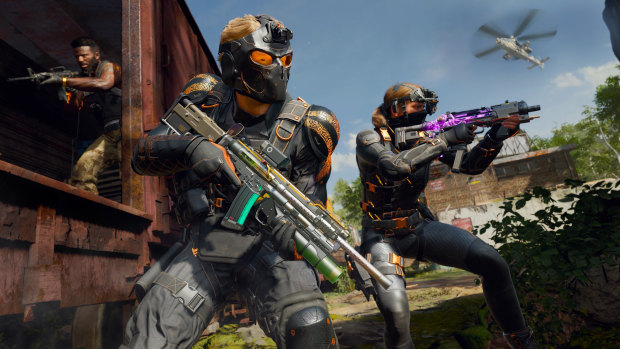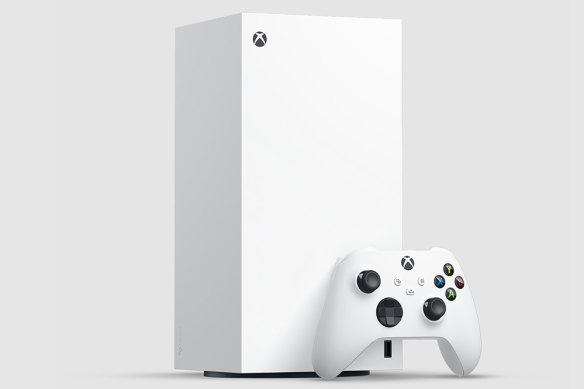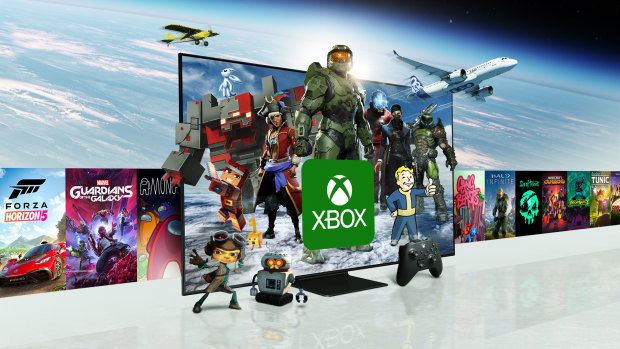- Analysis
- Technology
- Video games
This was published 5 months ago
Xbox goes disc-free with Call of Duty the star attraction
By Tim Biggs
With its powerful consoles, convenient streaming service and huge stable of creative developers, Microsoft’s Xbox brand is arguably as strong as it’s ever been.
Yet at the same time, it’s increasingly shifting away from being a like-for-like competitor to Sony’s PlayStation and towards being a fully-fledged arm of a massive tech giant. That’s reflected in the latest offering Xbox has for players going into the holiday season.
Xbox now publishes games on PlayStation and PC, meaning buying one of its own consoles isn’t a requirement for playing most of its games, and thanks to cloud streaming you don’t technically need a console at all. Microsoft’s aquisition of Activision Blizzard also turbocharged its content machine, giving it instant fuel to push onto mobile devices, develop larger-scale cash cows and expand its Game Pass subscription with the arrival of Call of Duty: Black Ops 6, which launched last week.

Competitive shooter Call of Duty, which is now owned by Microsoft, is often one of the best-selling games of the year.
At a time when Sony is about to release a more powerful system in the PlayStation 5 Pro, Microsoft has instead created a lower-cost refreshed version of its existing Xbox Series X, which removes the disc drive – a nod to the fact the industry has near-completely shifted to digital downloads. And it continues to sell the far less expensive Series S, which plays all the same games in lower fidelity.
All of Microsoft’s upcoming blockbusters, including this year’s Indiana Jones and the Great Circle, are expected to be available for Game Pass subscribers on PC and Xbox, but also for purchase on PlayStation and other platforms. Business-wise the strategy seems to be working, with the tech giant’s latest quarterly results showing that while hardware sales are down, overall gaming revenue is up 61 per cent year-on-year.

The Xbox Series X Digital Edition drops the disc drive and around $100, coming in at $700.
New console not an upgrade, but a high-end entry point
The Series X is an incredible console. It has a library spanning 20 years, meaning I can keep playing the Elder Scrolls IV: Oblivion save I started in 2007 (but now in 4K and a much better frame rate) on the same machine I use for this year’s Star Wars Outlaws. Features like seamless cloud saves, Quick Resume and Auto-HDR help you make the most of a huge gaming library (which even newbies have thanks to Game Pass) and are a big reason it’s my favourite console.
But the most important thing to understand about the new Series X Digital Edition is that if you already have a Series X, there’s absolutely no reason to upgrade. A comparison between the two does become more interesting though if you’re buying a Series X for the first time.
The black original console only has one advantage, and it’s a big one: you can insert discs into it. If you want to play Blu-ray movies on your console, or you have a bunch of Xbox discs that you wish to keep using, the Digital Edition is a non-starter.
Beyond that, everything is in the Digital Edition’s favour. It’s a far more visually attractive console, with the stark white body making its hard angles, floating base and convex circled vent cover much more striking, and the lack of a disc slot reinforcing its seam-free construction. Despite the big fan at the top, it never runs louder than a whisper. It also feels a kilogram or so lighter (I say this as someone who carries a Series X between rooms often).
I haven’t dismantled the digital Series X to look inside, but reviewers who have noted some key internal changes; namely an entirely new board and a shrunk-down processor. Microsoft hasn’t made a big deal of this because games run exactly the same, but in theory it should make the system more energy efficient. The Series X is already pretty good in this area when the console is not in use — keeping your games up to date while using the bare minimum power — but if you’ll be playing a lot, the new model could potentially save money on electricity.
And speaking of money, the console is $100 cheaper than the disc drive version, which isn’t a huge discount, but it’s not nothing. In times past I might have said it was smarter to go for the more expensive model because you’ll save more by buying discounted physical games, but that’s not necessarily the case any more.
If you buy many new games the day they’re released, and like the option of re-selling them when you’re done, then the disc drive will still save you money. If not, there’s something to be said for the convenience of buying digital; never needing to go to the store or wait for a package in the mail, being able to remotely install your games through a smartphone app, and snapping up games when they’re on sale or included in the sub.
Microsoft may introduce a more powerful machine in the next few years, but the Series X isn’t crying out for more performance. On a high-end TV, you’re getting up to 4K visuals at a 120Hz refresh rate, Dolby Vision HDR in games and a wildly fast storage drive. For anybody upgrading from a Series S, or entering this generation of Xbox for the first time, either of the Series X consoles will be incredible. It’s just a matter of whether you want the disc drive or not.

Game Pass Ultimate subscribers can stream games from the cloud directly to Samsung TVs, Amazon set-top boxes and many other devices.
Game Pass and the Call of Duty effect
With all this talk of Game Pass, non-subscribers might be wondering if now’s the time to jump in, especially since Call of Duty has arrived.
When the service was first hitting its stride around five years ago, it was easy to recommend. You paid $11 per month, and you got access to every single Microsoft-published game on the day it was released, plus a growing library of other games. But Xbox’s expansions and acquisitions (costing Microsoft far in excess of $100 billion) have clearly put pressure on it to make more money. And so, Game Pass has become more complicated.
Today there are three different Game Pass plans for Xbox consoles. The basic ‘Core’ offer is still $11 per month, but it only gets you access to a small and infrequently updated library of around 30 games. ‘Standard’ is $16 per month and gets you almost the entire library, which is now hundreds of games large. But the only way to get brand new Microsoft-published games on the day they release is to subscribe to ‘Ultimate’ at $23 per month, meaning the original selling point of the service is now exclusive to a tier more than twice the original price.
Ultimate does have other perks; you get access to the full library of PC games and cloud streaming, so you can play on any device whether it’s your Windows laptop or Samsung smart TV, and it’s the only tier that includes a back catalogue of sports and Star Wars games from EA.
Is $23 per month a fair price for all of that? I think so, but only if you’re using it. If you mainly want Game Pass to play Call of Duty or Indiana Jones on day one, maybe not. If you’re exclusively a Call of Duty player you could buy the new game for the equivalent of around four months of Game Pass Ultimate. Of course, Microsoft doesn’t care which path you go down because it gets the money either way, and you have to subscribe to some tier of Game Pass or other in order for your console to access online multiplayer.
Potentially the bigger impact of Call of Duty on Game Pass is that subscribers who aren’t big into shooters (let’s say, grazers who use the service to play many different genres of game) now have access to this massive franchise without having to drop $100. The strength of the subscription has always been that players who could previously only afford one or two games per month can now play dozens, and bringing Call of Duty to those players is a big deal.
Speaking to GamesIndustry.biz, Wedbush analyst Michael Pachter said Game Pass could grow by three or four million subscribers as a result of the game’s inclusion, but that around a quarter of its existing 30 million subscribers would likely have paid the $100 on top to get the game. That means Microsoft is trading full-game sales for a larger subscription audience, and more Call of Duty players to potentially monetise through in-game purchases.
Get news and reviews on technology, gadgets and gaming in our Technology newsletter every Friday. Sign up here.